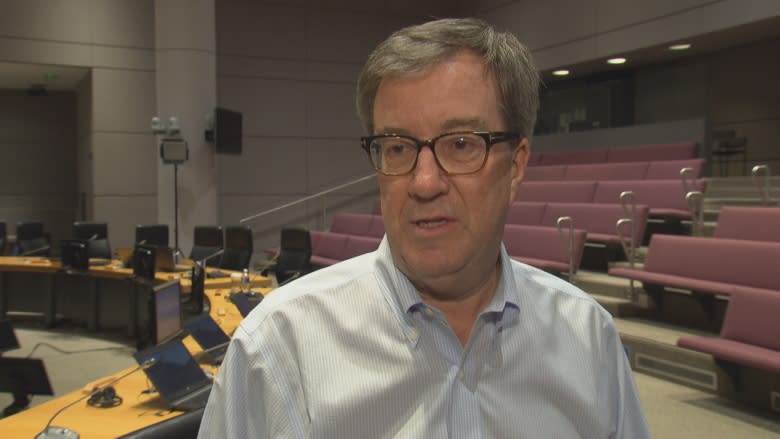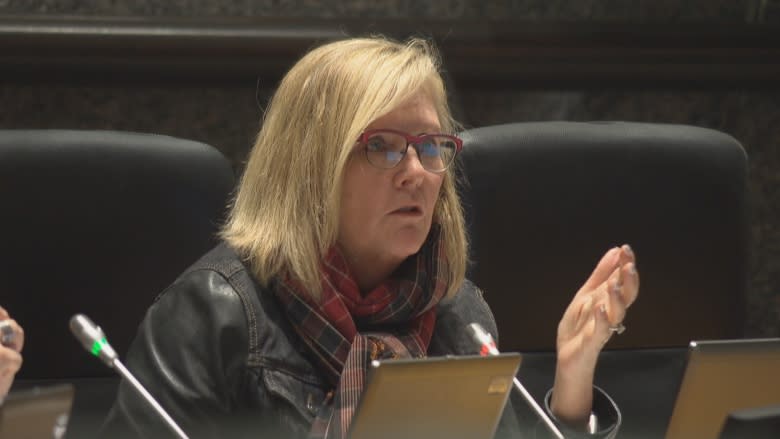Airport CEO asks city for more seamless LRT ride to downtown
The future light rail ride between the Ottawa International Airport and downtown should be more seamless, especially during off-peak times and on weekends, the airport's CEO told city councillors and the mayor as they debated plans for more than $3 billion worth of light rail construction.
On Friday, the finance and economic development committee unanimously approved the wide-ranging procurement and design plans for Stage 2 of light rail, with its long and complicated list of recommendations.
Details emerged when the massive staff report was made public Feb. 17: the trip from the Ottawa International Airport to downtown would take about 40 minutes.
That would involve a transfer at the future South Keys station and again at Bayview, where riders would switch from the diesel-powered Trillium line to electric cars on the east-west Confederation Line into downtown.
Airport CEO asks for better transit ride
Vehicle congestion at the airport is getting worse, CEO Mark Laroche told the finance committee.
"Business and leisure travellers to and from the airport need predictability, reliability and frequency if they're going to use mass transit to and from the downtown core," said Laroche, who has advocated for the airport link.
Laroche told the committee he's reassured because the station at South Keys will be built in a way that still allows the possibility for airport trains to travel straight to Bayview.
He asked that when the contract goes out to tender this spring, the city ask bidders to propose ways to allow trains to travel without transfers at South Keys, at least on weekends and off-peak times.
The city is open to ideas for faster service, said Mayor Jim Watson.
"But we don't want to mislead people. We think what we've put forward is realistic and affordable and within budget," he told reporters.
Rail link not in original plans
That said, the airport's CEO said he's pleased the terminal will get light rail at all, because it wasn't part of the original plans.
In June 2016, the city announced it would take light rail to the Ottawa International Airport and EY Centre after all, so long as the $155 million four-kilometre line — a branch of the main Trillium O-Train line to the Riverside South area — is paid for by the federal and provincial governments with no city money.
City staff said on Friday that even though the LRT system will be built to allow for future changes, they expect far fewer riders using the airport link and far more commuting to the Riverside South area on the main Trillium Line.
They said any decision to create a more direct trip between Bayview and the airport should be made years from now.
"I think there's a misguided notion that all the big cities in the world have some fast train from the airport into downtown," said Coun. David Chernushenko.
In his travels, he said he's found the opposite: most airports involve transit transfers.
"I don't think it's a flaw in the plan to be offering the fastest and most frequent service to the daily ridership of the people who live here and are paying taxes here," he said.
Coun. Diane Deans also asked about about the possibility of electrifying the Trillium Line so it doesn't run diesel trains, but staff noted that would add at least $300 million to the current $535 million budget for expanding the Trillium LRT line south, and up to $1 billion extra if it meant creating dual rather than single tracks.
The west is next
Even as the city is discussing Stage 2, before Stage 1 even opens in 2018, representatives from Kanata's business community asked for the city to think ahead to Stage 3 of light rail and set its sights on Kanata.
Jenna Sudds of the Kanata North business improvement area said she's pleased light rail will likely reach Moodie Drive by 2023, which is earlier than expected.
But employers in the Kanata North business park want to hire young talent, she said, and those employees tend to like downtown living and want better transit access.
That's why the city has sped up Kanata's environmental assessment, said the mayor.
"Going to Moodie is the down payment on Kanata," said Watson, who considers Kanata to be the next transit priority even if the city doesn't yet have the money for it.
Watson also supports a motion that Barrhaven councillor Jan Harder will discuss on March 8, which proposes the city find a way to hook Barrhaven residents into the light rail line sooner rather than later, perhaps by converting the southwestern bus Transitway for rail.
The dozens of staff recommendations that set out the tenders, design and management oversight for the Stage 2 of Ottawa's light rail project, plus its related road and water projects, comes to full council at that same meeting on March 8.
Before that, staff will hold a citywide information session on March 1, from 6:30 to 8:30 p.m. at city hall. It will also be webcast on the city's site and on social media.



